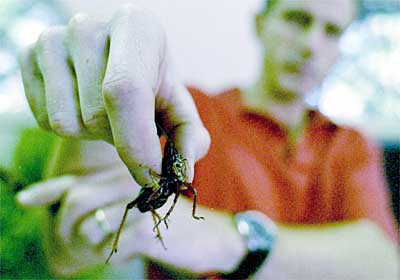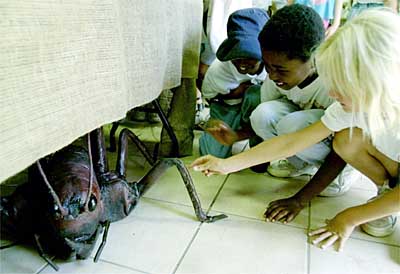
March 24, 1999
These Streets Belong to the Pre-Millennium
Bug
By DONALD G. McNEIL Jr.
JOHANNESBURG -- Insect of the Year for the
year 2000 may be the millennium bug. But here in
the shady gardens (and sometimes the quiet
bedrooms) of the northern suburbs, 1999 belongs
to the real chitinous-skeletoned thing, the tiny
scourge of Johannesburg known as the Parktown
prawn.

|
| Modern entomologists like
Marcus Byrne say they are delighted that
the insect has moved to Parktown. He held
a Parktown Prawn at arm's length.
Credit: Joao Silva/Sygma, for The
New York Times |
Few Americans -- even few New Yorkers, who can
keep their cool around cockroaches the size of
the villain of "Men in Black" -- have
heard of Parkies. They are lucky. Johannesburg is
rife with stories of locals who have leapt
shrieking from their beds, flung shoes out
windows and nearly crashed their cars, all
because they found themselves mandible to
mandible with a big orange wiggly-antennaed,
barbed-leg prawn.
"The males have very large jaws, and the
females have big, scimitar-shaped ovipositors, so
they're quite fierce-looking," said Caroline
Crump, curator of the zoology museum at the
University of the Witwatersrand here. "And
if they're cornered, they may jump at you.
They're just trying to get away, but people think
they're attacking."
The prawn's tough hide makes it newspaper- and
slipper-resistant. At up to three inches long, it
has enough body mass to shake off most household
insecticides -- the first shot just makes it more
jumpy.
|

The New York Times |
|
|
Worst of all, when threatened, it empties
its bowels of a noxious black effluvium that
disgusts predators and Parktonians alike.
In truth, Libanasidus vittatus is no prawn,
nor is it confined to Parktown, a section of
northern Johannesburg. It is a king cricket. But
it does avoid poorer neighborhoods, which tend to
be dry, preferring the wet, leafy gardens of
elegant old mansions.
As a species, it may be 200 million years old,
but it celebrates its centenary this year. It was
first described in 1899 by the entomologist
William Kirby, whose first example still resides
at the Natural History Museum in London.
No one is blasť about them. The squeamish
scream. The first human words heard by most
prawns intrepid enough to explore houses are
"Eww, gross!" But entomologists in
Pretoria, which is only 40 miles away, "are
very jealous that we have them and they
don't," said Marcus Byrne, a Johannesburg
entomologist.
"As a publicity hook, it's a brilliant
animal."
The prawn is the centerpiece of an insect
exhibit he and Professor Crump opened at the
Johannesburg Zoo recently.
Earlier this year, the insect got its
own Web site.
And, "if there's enough demand, we might
have a formal birthday party," said Prof.
Rob Toms, curator of entomology at the Transvaal
Museum in Pretoria. "To the best of my
knowledge, that would be the first time anybody
did that for a bug."

|
| Schoolchildren played with a
replica of the Parktown Prawn, a member
of the cricket family, during an
exhibition at the Johannesburg Zoo. As a
species, it may be 200 million years old,
but it was first described in 1899 by the
entomologist William Kirby.
Credit: Joao Silva/Sygma, for The New
York Times |
Greatness is being thrust upon the lowly
Parkie. Johannesburg's rough-rock-and-shock-yak
radio station, 94.7 Highveld Stereo, whose sound
signature is the beer belch of the host of its
"Rude Awakening" morning show, has just
adopted it as its billboard icon. Where the
British crown employs a lion and a unicorn to
guard its coat of arms, 94.7 has two prawns
rampant flanking an old microphone.
Curiously, though, it is not a Johannesburg
native. Mr. Kirby found his first in Barberton, a
small town on the forested lowveld. Johannesburg,
up on the flat highveld savannah, was once too
hot and dry for them. But trees, lawns and
swimming pools have modified the habitat
invitingly.
In truth, Professor Crump said, Parktown
residents should be grateful that it migrated
here. Given their druthers, prawns will eat
garden snails all night long rather than hop into
the dog dishes where they are often found on wet
summer mornings.
She worries that they may be threatened.
Another South Africa native that has adapted to
urban gardens, the hadeda ibis, enjoys prawn
dinners. Fat gray hadedas, named for their
raucous "hah-dee-dah" cries, are on the
increase and prawns "are getting harder to
find each year," Professor Crump said sadly.
Extinction can't come too soon for some
people. Jenny Crwys-Williams, a talk show host on
Radio 702, occasionally encourages listeners to
call in and describe their worst prawn days.
"In our violent society, they've assumed
a legendary status," she said. "They
just keep coming. You can't stop them."
A disturbing number of her listeners describe
moments in which their first realization that
they weren't alone in the bathroom was a faint
tickling sensation on their bare bottoms.
Ms. Crwys-Williams said her favorite caller
was a woman who had been taking a bath with
cucumber slices on her eyes. She felt something
scratchy on her sponge as she soaped herself, and
ran screaming into her garden stark naked. A
brave neighbor, hearing the screams, immediately
vaulted the garden wall.
Professor Crump said she can top that. A woman
who visited her museum "to talk about some
other bug," she said, had a daughter who
woke up to find one on her pillow, staring at
her.
"She screamed, and it was so startled it
jumped in her mouth," she said. "When
she pulled it out -- you know it has those barbs
on its legs -- one of them got stuck. She had to
go to hospital."